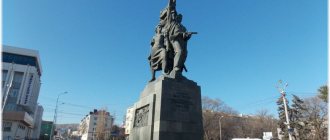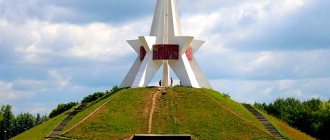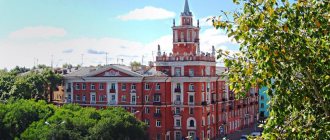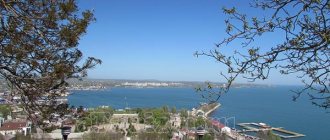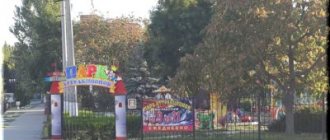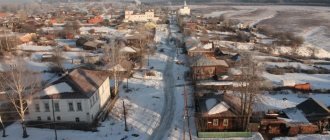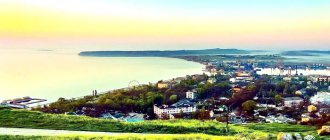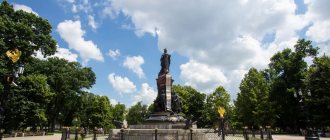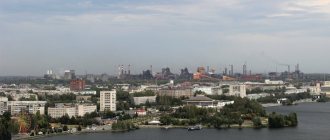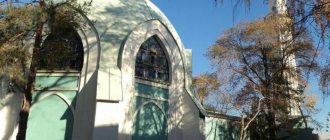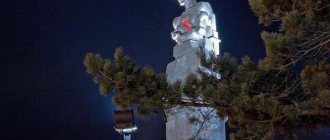Kerch is the most ancient city of Crimea, unlike others. The sights of Kerch include historical monuments, witnesses to the city’s glorious military past, and sandy beaches stretching for many kilometers, with their picturesque and little-explored bays. Kerch is a real open-air museum.
During the Great Patriotic War, Kerch became the scene of fierce battles; the front line passed here four times, twice it was occupied by German-Romanian troops. During the war years the city was almost completely destroyed. For mass heroism and courage in defending the Motherland, Kerch received the title of hero city.
Sights of Kerch
Mount Mithridates
Kerch is a unique tourist center of Crimea, which dates back 26 centuries. It has the largest concentration of archaeological sites on the entire eastern coast of the peninsula. Many historical sights of Kerch are associated with its strategic location near the Kerch Strait, separating the Azov and Black Seas.
Lenin Street
These monuments are evidence of centuries-old rivalry over the strait. These include mounds preserved from the time of the Bosporan kingdom and the ruins of ancient cities. The highest point of Kerch is Mount Mithridates (91.4 m), around which most of the city’s attractions are concentrated. The newest attraction of Kerch is the Crimean Bridge.
Chronology of events of the liberation of Kerch
Table of events in chronological order
| date | Event |
| 12.09.1941 | Advanced German units enter Crimea |
| 27.10.1941 | The city of Kerch is subjected to daily bombing by Lutwaffe aircraft. |
| 04.11.1941 | The Kerch defensive region is being created |
| 14.11.1941 | The command makes a decision to evacuate troops from Kerch to Taman |
| 16.11.1941 | First occupation of the city of Kerch |
| 27.11.1941 | German soldiers hold a parade on the main street of the city |
| 26.12.1941 | Landing of troops in the area of Kamysh-Burun, Stary Karantin and Eltigen. |
| 30.12.1941 | The first occupation of Kerch ended. |
| 28.01.1942 | New Crimean Front. |
| 28.03.1942 | Hitler announces a plan to capture Kerch, “Hunting for Bustards.” |
| 07.05.1942 | The beginning of the German. |
| 13.05.1942 | The city of Kerch is again subject to airstrikes. |
| 15.05.1942 | Second occupation of Kerch. |
| 18.05.1942 | The defenders of the city are dying on the territory of the Voikov plant. |
| 19.05.1942 | Mass executions of the male population by the Nazis. |
| 20.05.1942 | The last 2 thousand soldiers who fought on the territory of Yeni-Kale die. |
| 31.10.1943 | Beginning of the Kerch-Eltigen landing operation |
| 02.11.1943 | The landing force completely lands in the village of Eltigen |
| 04.11.1943 | The Germans take control of the Kerch Strait |
| 07.12.1943 | The landing force breaks through to the center of Kerch and occupies Mount Mithridates |
| 11.12.1943 | Paratroopers retreat from the city |
| 08.04.1944 | Attempt to liberate Kerch |
| 11.04.1944 | The end of the second occupation of the city of Kerch |
| 08.10.1944 | An obelisk of glory is being erected on Mount Mithridates |
Crimean Bridge
The Crimean Bridge connects the Crimean Peninsula with the Taman Peninsula (Krasnodar Territory) across the Kerch Strait. Its length is 19 km. The bridge begins on the Taman Peninsula, near the village of Taman, passes along the sandy island of Tuzla, crosses the strait and goes to Kerch.
Construction of the bridge began in February 2016. The Crimean Bridge received its official name at the end of 2022 after an online vote. The grand opening of the four-lane road bridge (section of the A-290 highway) took place on May 15, 2018, and its operation began the next day. The second parallel part of the bridge, the railway part, was inaugurated on December 23, 2022 with the participation of President Putin.
Thanks to the Crimean Bridge, the sights of Kerch and the entire Crimea have now become more accessible to residents of Russia.
The beginning of the war - the attack on the Kerch Peninsula
The Second World War came to Kerch in the summer of 1941. Two brigades are being formed in the city - the people's militia and the destroyer battalion. In the first months of the war, more than 1,500 volunteers and more than 15 thousand conscripts went to the front. Thousands of Kerchan residents of non-conscription age – young boys and girls – are joining the people’s militia.
The evacuation of civilians began in August, and of industrial enterprises in September. Despite the shortage of equipment and personnel, the Kerch Metallurgical Plant continues to produce flamethrowers, grenades, mortars, and anti-tank incendiary mixture for the front. In the first months of the war, the plant produced two armored trains.
Kerch Metallurgical Plant 1942 Source: waralbum.ru
Advanced German units enter Crimea on September 12 and begin an offensive in the direction of the Kerch Peninsula. Kerch is one of the main strongholds of the peninsula. From here the path to the Taman Peninsula and the Caucasus was open for the Nazis.
Focke-Wulf FW-190 aircraft
Since October, the city begins to be bombed daily by Lutwaffe planes. Since October 27, real hell has been happening in Kerch. More than 600 air bombs are dropped on the city, the railway junction and port are completely destroyed. Kerch burned for several weeks.
On November 4, the Kerch defensive region was created, which includes the Kerch naval base and units of the 51st Army. But this no longer helps stop the enemy. By this time, Soviet units were holding out on the Kerch Peninsula with all their strength.
The KVMB observation post was located on the Mithridates Stairs. Source: waralbum.ru
There was only one way out - to save the army’s equipment and weapons. Otherwise, the Germans will inevitably defeat the remnants of the troops and move on - to Taman and to the Caucasian oil.
The command decides to evacuate troops on November 14. Retreating, Soviet troops blow up fuel depots, a floating dock, the Voikov plant, a water supply system, and power plants.
Several dozen civilian ships and fishing seiners are transporting about 50 thousand soldiers and over 400 guns from Kerch to Taman. The evacuation takes place under constant fire from enemy artillery and mortars.
Great Mithridatic Staircase
The Great Mithridates Staircase is a real visiting card of Kerch, which is depicted on all postcards with views of the city. This impressive staircase, decorated in a classical style, was built between 1833 and 1840. designed by the Italian architect A. Digby. It was designed to connect two key attractions of Kerch - Mount Mithridates and the Church of John the Baptist.
The staircase has 432 steps, the landings between which are decorated with beautiful decorative niches with vases. This difficult climb is worth the effort - from the top of the mountain there are panoramic views of the city and the bay.
On the upper tier of the stairs, the visitor is greeted by stone griffins - mythical creatures with the wings and head of an eagle and the body of a lion.
Stone sailboats
The guide to Kerch contains information about unusual stone sailboats. 4 kilometers from Kerch there are rocks in the sea - Elken-Kaya. Otherwise they are called Stone Sailboats. This is a unique natural attraction. There are four rocks, the highest of which reaches 20 meters.
If you look at them from a distance, they really do resemble small sea boats. Thanks to the limestone reef rock that the rocks are made of, they are very strong. To explore the attraction up close, a boat runs for tourists.
The Legend of the Stone Sailboats
There is an ancient legend associated with the rocks. According to it, previously this place was inhabited by happy people who once saved two women who were victims of a shipwreck.
Beautiful ladies, instead of gratitude, repaid by enslaving people who knew troubles. One of the sages was able to help the people regain independence. The women turned into birds and flew away. After this, the Opuk rock appeared on the site of their former greatness, and in the area of the shipwreck, 4 cliffs resembling sailboats rose from the water.
Obelisk of Glory
Kerch is one of 12 cities in the Soviet Union that received the title of hero city. In May 1942, the city was captured by German troops, and during fierce fighting the city was heavily destroyed. Then Kerch became the last frontier of the Crimean Front, which had to retreat through the Kerch Strait to the Taman Peninsula. The remnants of military units that were unable to evacuate concentrated in the Adzhimushkai quarries and continued resistance.
At the top of Mount Mithridates there is a 24-meter Obelisk of Glory - a monument to the defenders of the city who died in the battles for the liberation of Crimea during the Great Patriotic War. Near the obelisk there is a marble memorial plaque in the shape of an open book. The obelisk was erected in 1944, and in 1959 the eternal flame was lit here.
Obelisk of Glory on Mount Mithridates
One of the most famous brands of the former Panticapaeum is set at a dominant height - an “elite” hill, named after the Pontic despot Mithridates. Once upon a time, Soviet troops controlled the entire agglomeration from here. The point is strategic - from here the lens of your camera will look at any corner of the settlement, and most importantly - the excavation sites of ancient (Bosporan) quarters. Drive to Lenin Square (there is a lot of traffic passing through here). Pedestrian streets begin a little higher, which will lead you to the “arteries” that wrap around the mountain.
The memorial, which is a small square edged with granite fences, was placed in August 1944. We are talking about the brainchild of the famous architect Kiselev. The remains of the Trinity Cathedral were used for construction. The conversation is about memorial plaques with the names of 146 heroes - fighters of the Separate Primorsky Army and the Azov Flotilla, who fought in the city from November 1943 to April 1944. The boards surround the obelisk itself, made of gray stone - with a star. It is 24 meters high and visible from a distance of 20 km. Nearby is a lighthouse tower with a repeater, where tourists climb to photograph the surrounding panoramas. Finally, on the site itself you will find examples of the anti-aircraft equipment used.
Panticapaeum
Panticapaeum is the former capital of the Bosporan Kingdom, founded by the Greeks back in the 7th century BC. It occupied an impressive territory: about 100 hectares - almost the entire top of Mount Mithridates. It included the temple of Apollo, a palace, a theater, an agora - a square for public meetings - and other buildings. Panticapaeum flourished - it was located at the intersection of many trade routes leading to China, the Mediterranean, and Central Asia. In the first centuries AD the city was destroyed by the Huns.
Today, numerous tourists have the opportunity to appreciate the former scale and grandeur of the ancient city from the surviving remains of buildings. The main dominant feature of the Prytanean polis is a structure with two columns (III century BC). On the northern slope of Mount Mithridates, archaeologists also discovered an ancient necropolis with more than 3.5 thousand crypts.
Entertainment and leisure in Kerch
Entertainment in Kerch: you can brighten up your leisure time by visiting an art gallery. It is located at the foot of the mountain, in the center of the city. For the gallery, local authorities allocated a 2-story building in the classicist style. It is part of the ensemble of the Mithridates Staircase. The gallery contains the most important exhibitions dating back to ancient times.
- Various thematic exhibitions are constantly held. In the gallery you can admire finds that are over 1000 years old. The permanent exhibition features painted vases, glassware, etc. Many exhibits are presented in photographs.
- There are many museums in Kerch. One of the most interesting is dedicated to fisheries and oceanography. The museum simultaneously studies marine resources. This association is one of the specialized Russian institutes. The museum contains various maritime exhibits from all over the world.
There are more than 4000 copies in total. At the exhibition you can admire the sawfish, the long-extinct goblin shark, rock perches reaching a length of 4 meters and many other unique exhibits. There are also historical and ethnographic museums.
Crimea is an amazing place that you always want to return to more than once. Kerch is one of the most ancient cities and will delight tourists with its unique highlights. Excursions can be either family or single, and if desired, guests can always relax by the sea .
Crypt of Demeter
Technological model of the Crypt of Demeter
An antique burial chamber (2nd century BC), dug in natural soil and covered with fresco paintings, was discovered in 1895. In the center of the painted vault is an image of the goddess of fertility and agriculture, Demeter, which is why the crypt was named after her. Throughout the 20th century, the crypt was destroyed mainly by dampness.
In 1998, at the foot of Mount Mithridates, a technological copy of the crypt was created, painted with frescoes like the original crypt.
Adzhimushkay quarries
Memorial complex “To the Heroes of Adzhimushkay” and the museum entrance to the quarries
Address: microdistrict Adzhimushkay, st. Brothers Malchenko, house 34-36. Opening hours: from 9.00 to 17.00. The ticket office closes at 15.45. Closed on Monday. Children under 6 years old are not allowed into the museum. Cost: underground museum (1.5 hour excursion) - 400 rubles, beneficiaries - 300 rubles, under 16 years old - 85 rubles. Exhibition “Weapons 1941-1945” - 120 rubles, under 16 years old - free.
The most famous military-historical monument of Crimea and one of the most visited military museums of the peninsula, opened in 1967, is the Museum of the History of Defense of the Adzhimushkay Quarries . Once upon a time, shell rock was mined here, first in an open, then in a closed way, from which underground caves were formed. Here in May 1942, the remnants of the Crimean Front took refuge, unable to evacuate with the main personnel to the Taman Peninsula.
The Adzhimushkai quarries are a real underground fortress, the garrison of which in 1942 heroically fought for 170 days against the fascist invaders in the completely occupied Crimea.
Museum Adzhimushkay quarries
With an acute shortage of food and supplies and the constant inhumane attempts of the Germans to break resistance, the soldiers steadfastly held the line and even made regular attacks. As in the Brest Fortress, the most important thing was missing here - water, every drop was precious. We had to live without light and in constant cold.
The enemy nevertheless captured the quarries, and the defenders of the underground garrison did not wait for help. Of the more than 13 thousand people, very few remained alive. The survivors were taken into captivity, which not all survived; some of them died in battles after being freed from captivity. About 200 people survived the war; at present, none of them are alive.
Museum visitors will be able to see the former gas shelter, operating room and garrison barracks. The total length of the route is about 400 m. Of the 170 hectares of quarries, only 1 belongs to the museum. A visit to the Adzhimushkay quarries is not an entertainment event; this place is considered one of the most terrible and tragic in the Crimea. To pay tribute to the courage and self-sacrifice of Soviet soldiers, to remember at what terrible cost the victory was achieved - this is what people come here for.
Monument to border guards in Adzhi-Mushkai
And again the “tragic” Adzhi-Mushkay. Not far from the memorial group and the underground museum “Adzhimushkai Quarries” we will meet an ensemble consisting of a boundary pillar and a memorial slab with an inscription (all this is placed on a granite pedestal, where a staircase leads). The object is visible in the wasteland. You won't get lost.
The complex is dedicated to the front-line soldiers of the 95th Border Regiment, who fell in two military operations at once near a populated area. The object was reconstructed in 2010 (before that there was only a pillar). There are still a lot of monuments dedicated to the Second World War in the city of Kerch, for example, to Soldiers-Aviators, Paratroopers, a composition in Voykov Park, etc.
On topic: Museums of Kerch
Pay attention to the photo. The WWII monuments in Kerch are dedicated to both the soldiers of that terrible war and its victims among the local population. Some compositions are positioned so that they are clearly visible from the sea, and from afar. Reviews call the city we described as “the place of Glory of several wars at once.” Appreciate each work of monumental sculptors. As a rule, their works are shown by guides. In conclusion, we offer an educational video, enjoy watching.
Liked? Share with your friends!
Royal Kurgan
The Royal Mound, built at about the same time as Melek-Chesmensky on the outskirts of the village of Adzhimushkay, is an impressive structure with a perimeter of 250 meters and a height of about 18 m. It is a mound, inside of which there is a burial room and a long 36-meter path leading to it. meter long corridor - dromos.
The walls of the burial room narrow towards the ceiling, forming a dome: the ancients believed that through it the purified soul passes into eternity. No burial was found in the mound: it was either looted or the burial did not take place.
Monument "Sail"
We are talking about the main symbol of old Eltigen, because it expressively designates the shore of the Geroevskoye microdistrict (this is already a new toponym) from the sea. The village is even included in the second name of the monument - “Heroes of Eltigen”. You can take minibus No. 15 (stop “Magazin”). Your own transport? Continue along the street. Red slide and signs.
The monument appeared on the right date - May 8, 1985. It was placed 27 meters from the sea - opposite the Summer Breeze hotel (to the southwest the “hotel-sanatorium” zone of Geroevka begins). To the north is the city beach and tourist centers. All this suggests that this location is difficult to pass by. The reinforced concrete monolith, 20 m high, really resembles a sail – stretched out in the wind. The weight of the colossus is 2000 tons.
Why a sail? The fact is that this piece of the coast was dedicated to the famous landing force that landed in Eltigen on the night of November 1, 1943. Soviet troops captured a fragment of the bridgehead, later called Tierra del Fuego. The Eltigens were fired upon for 40 days and nights, they repulsed at least 10 attacks, but they survived.
Yeni-Kale Fortress
Address: Kerch, st. Minina
The remains of this landmark of Kerch are evidence that the city at all times occupied an important strategic position. The Yeni-Kale fortress “new fortress” was built by the Crimean Tatars in 1706. During the Russian-Turkish War, the fortress was surrendered to the Russian army without a fight in 1771.
During the Great Patriotic War, the fortress again temporarily became a strategically important object in which the defenders of the city took refuge. After the war, Yeni-Kale was restored and received the status of an architectural monument.
During its heyday, the Yeni-Kale fortress was an impressive three-tiered structure in the shape of an irregular pentagon. Outside, the fortress was surrounded by a rampart and a ditch. On its territory there were gunpowder warehouses, an arsenal, barracks, a mosque and a reservoir with drinking water supplies.
Entrance to the fortress territory is free. The walls, the Azov Gate and the bastions of the fortification have been preserved to this day. The picturesque surroundings of Yeni-Kale are also of interest to tourists and hikers: it offers a beautiful view of the Kerch Strait.
Soviet Dunkirk
The evacuation from Kerch was not organized and took place in a hurry. At first, only the wounded, artillery and Katyushas are taken out. Then the removal of the remaining troops and population began.
We managed to find 158 ships for evacuation - the “Tulkin fleet”. It mainly consisted of seiners, minesweepers, longboats, and tugs. And not all of them were in good condition.
Covering the retreat, the remaining units fought to the end. But thousands of people – civilians and military – gathered on the shores of the Kerch Strait. And it was clear that there was not enough space on the ships for everyone.
Logs were knocked together on the shore, homemade rafts were built, and floats were made. Many tried to escape by swimming. There were screams and moans above the shore. And all this under constant enemy bombing.
There were no analogues to what was happening in the entire history of the Second World War.
According to the Soviet command, about 140 thousand people managed to evacuate through the Kerch Strait. Approximately 17 thousand of them crossed independently.
Kerch fortress
Another masterpiece of fortification art, located on Cape Ak-Burun. The fortress was built under the leadership of the general and architect E.I. Totleben and has seen many historical events in its lifetime. Construction began back in 1857 after the Crimean War and lasted 20 years, ending only at the beginning of the Russian-Turkish War of 1877. During the Great Patriotic War, the fortress was repeatedly bombed, but its defenders managed to hold back the onslaught of the Nazis until the last.
There are underground passages on the territory of the fortress, with which many stories are associated. They connected the fort with the coastal batteries. Even today, not all underground tunnels have been found.
Melek-Chesme mound
The Melek-Chesme mound is located in the central part of the city and is named after the river flowing nearby. This monument of ancient funerary culture dates back to the 4th century BC. e. The height of the mound is about 8 meters. The mausoleum is made in the form of a pyramid, reminiscent of an Egyptian one. The first excavations began in 1858. To the chagrin of the scientists, the mound turned out to be plundered - no valuables were found in it.
The walls of the mound were made of carefully cut stones without the use of mortar - this technique came from Greece and Asia Minor.
Temple of John the Baptist
Address: per. Dimitrova, 2.
According to legend, the Church of John the Baptist was built on the spot where the Apostle Andrew preached. This is the oldest operating Orthodox church in Eastern Europe, built in the 8th century. One of the magnificent examples of Byzantine architecture, with a series of white and red stones characteristic of this style and a single dome.
During the era of the Crimean Khanate, the Church of John the Baptist was converted into a mosque. It became Orthodox again only in 1774, when Crimea became part of the Russian Empire. During the war years, this religious building was badly damaged by fire. In the 80s of the last century, the temple was restored, and in the 90s it was reopened to parishioners.
Heroic Crimea: TOP 10 monuments of the Great Patriotic War
SIMFEROPOL, May 7, 2016 - RIA Crimea. The first monuments dedicated to the period of the Great Patriotic War appeared in Crimea immediately after its liberation - in the spring of 1944. Today there are more than 2 thousand of them. In the legendary Sevastopol alone there are about 400 sculptures erected in honor of the heroic events and valiant people of this bloody war. Thus, on the peninsula there are monuments dedicated to pilots, tank crews, sailors, partisans, medical workers, journalists, military equipment, individual military units and certain people who distinguished themselves during the war. They all fought for the Crimean land and brought the Great Victory closer. On the eve of Victory Day, RIA Crimea has compiled a TOP of monuments that are reminders of those years and will be of interest to guests of the peninsula. Obelisk of Glory on Mount Mithridates
In Crimea, one of the first monumental monuments dedicated to the events of the Great Patriotic War was the Obelisk of Glory on Mount Mithridates in Kerch. It was opened in 1944. The monument was erected in memory of the soldiers and officers of the Separate Primorsky Army and the sailors of the Azov Military Flotilla, as well as all the soldiers who died in the battles for the liberation of Crimea. The obelisk was built from the stones of the Holy Trinity Cathedral, which at that time was considered the central church of Kerch. The triangular monument, 24 meters high, rests on a massive three-step pedestal in the shape of a trefoil. Each of its protrusions has 76mm cannons. On the obelisk itself you can see a bas-relief image of the Order of Glory, and on the pedestal you can read the memorial text. Later, a wall was built near the pedestal in the form of an open book, on which are carved the names of the soldiers who fell in Kerch, including Heroes of the Soviet Union. And in 1959, the Eternal Flame was lit near the obelisk.
Monument “Sail”
On the shore of the Kerch Strait there was a monument “Sail” dedicated to the Eltigen landing. It is located on a hill in the village of Heroiskoe (Kerch), at an altitude of 30 meters above sea level. Thanks to this, the monument is clearly visible both from the sea and from the shore. At the place where Parus was installed, the landing force heroically held the bridgehead from November 1, 1943 to December 9, 1943. The height of the reinforced concrete monument, created in the shape of a sail, is 20 meters. On the front side of the monument there is a wall with voluminous bas-reliefs depicting scenes of landing battles with the Nazis, and at the foot of the hill there are steles with the names of Heroes of the Soviet Union, the names of military units and ships that took part in the landing. According to the authors, “Sail” is an allegorical expression of the idea of the movement and onslaught of Soviet soldiers overcoming enemy resistance.
Monument in honor of the heroes of the defense of Sevastopol
In the center of Sevastopol, on Nakhimov Square, a large-scale monument dedicated to the feat of the city during the Great Patriotic War was erected. It is a concrete wall with a relief image of a warrior who repels an enemy attack. Enemy bayonets are pointed at the soldier, symbolizing three Nazi offensives in 1941-1942. Memorial plaques are installed under the monument. On one of them there are the words: “The exploits of the people of Sevastopol, their selfless courage and dedication, rage in the fight against the enemy will live for centuries, they will be crowned with immortal glory.” On others, the names of units and formations of the Black Sea Fleet, the Primorsky Army and city enterprises that worked for the front are carved. The monument was built in 1967. The Eternal Flame was lit next to him. Since 1973, young Sevastopol residents have stood guard at post No. 1 at the monument. By the way, Sevastopol, which held back a 300,000-strong enemy army for a long time, was awarded the title of “Hero City” in 1965.
Monument to the Sailor and Soldier
The monument “Sailor and Soldier” was erected in Sevastopol on Cape Khrustalny. The process of creating the monument lasted more than 30 years. Thus, the decision to build the sculpture was made in 1972, installation began in 1981, and was opened only in 2007, on the eve of Victory Day. The monument is a composition of figures of an armed sailor and soldier eager to fight. The monument stands on a horizontal pedestal. In front of it there is a tiled platform with a view of the Sevastopol Bay. The area around the monument has been landscaped, in particular, an alley of trees has been planted here. Due to its height (more than 40 meters), the monument is the most noticeable in the hero city.
Partisan hat
On the Angarsky pass, in the village of Perevalnoye, Simferopol region, a memorial sign “Partisan hat” was installed. It is located on the side of the road at 27 km of the Simferopol-Alushta highway. In these places, during the German occupation of Crimea, partisan detachments were active. For two and a half years, the people's avengers fought 252 battles and destroyed about 30 thousand opponents. At the same time, more than 4 thousand partisans and underground fighters died in battles with the fascists. In memory of their heroic deed, this sculpture was erected in 1963. The monument is an irregularly shaped block of stone, which is diagonally crossed by an insert of polished red marble. The object resembles a headdress typically worn by partisans. In front of the monument there is a memorial plaque, to the right of it is a stele with high reliefs of partisans, and to the left are two memorial plaques with the names of the victims. Every year on May 2, thousands of Crimeans come here for a partisan rally to honor the memory of the heroes who fell in battle.
Monument to the armored train "Zheleznyakov"
The legendary armored train "Zheleznyakov", built in 1941, belonged to the main base of the Black Sea Fleet. He actively participated in the heroic defense of Sevastopol during the Great Patriotic War. German soldiers nicknamed this car the “Green Ghost”. And for good reason. The armored train made 140 combat raids, inflicting heavy damage on the enemy in manpower and equipment. After each “soray,” the vehicle took refuge in a tunnel, where enemy batteries and aircraft could not reach it. Only in July 1942 did the Nazis manage to disable Zheleznyakov. In peacetime, the armored train was restored and traveled on the Crimean railways until 1967. After that, in memory of Zheleznyakov, his former auxiliary locomotive El-2500 was installed as a monument near the Sevastopol bus station. It bears the inscription “Death to Fascism.”
Monument to the paratroopers near Evpatoria
On the highway near the entrance to Evpatoria there is the most famous sculpture of the Saki-Evpatoria region, created in memory of the events of the Great Patriotic War - a monument to the paratroopers. A 200-meter Victory Banner was unfurled in Simferopol >> More than 700 marines landed on the Evpatoria coast in January 1942. As a result of fierce fighting that lasted several days, less than a hundred soldiers survived. Despite the defeat, the landing was able to divert part of the enemy forces from Sevastopol and helped consolidate the success of Soviet troops on the Kerch Peninsula. The monument is a sculptural composition that depicts the moment of landing on the shore. The central figure is a sailor with a grenade raised in his hand. To his right and left are two more sailors. On the triangular pedestal of the monument there is an inscription: “Your feat glorifies the Fatherland, its reward is immortality.” Initially, in 1950, a monument in the form of one sailor was erected on this site, but 20 years later it was replaced with a three-figure composition. The previous sculpture was moved to the cemetery of the village of Koloski (until 1948 - Oraz), in which 17 paratroopers died in an unequal battle with the Nazis.
Monument to a grieving mother
During the German occupation of Yevpatoria in 1941-1942, more than 12 thousand civilians were shot. In memory of the victims of fascist terror, the Red Hill memorial complex was created in the city in 1954, on the territory of which a monument to a grieving mother was erected. The sculpture is a three-meter bronze figure of a woman in a long dress, holding two roses in her hand. The monument is installed on a pyramidal pedestal more than 3 meters high. On the base in front of the sculpture the Eternal Flame burns. Nearby are a mass grave and a monument to the participants of the Evpatoria landing, whose remains were found in the park named after. Karaeva. Today “Krasnaya Gorka” is a place of worship for Evpatoria residents. They bring flowers to the monument to the grieving mother on Victory Day and other memorable days. In addition, wedding processions come here to honor the memory of executed townspeople.
Monument to the Liberators of Feodosia
In the Yubileiny Park in Feodosia there is a monument to the soldiers of the Separate Primorsky Army, who in April 1944 liberated the city from the Nazi invaders. A monument in honor of valiant warriors was erected in the park in 1970. It is a 16-meter steel column. It is crowned with a bronze image of the Order of the Patriotic War, 1st degree. At the foot of the sculpture the Eternal Flame burns. To the right of the monument there is a stele with memorial plaques on which are written the names of the commanders of units and formations who took part in the liberation of Feodosia. It is worth noting that in 2015, for the courage, resilience and massive heroism of the defenders of Feodosia, it was awarded the title “City of Military Glory.” At the moment, this is the only settlement in Crimea that has such an honorary status.
Monument to the T-34 tank
In the center of Simferopol, in Victory Square, there is a memorial sign in the form of the T-34 tank. It is also a reminder of the heroism of Soviet soldiers during the Great Patriotic War. During the liberation of Crimea from enemy troops, the 19th Tank Corps, which was part of the 4th Ukrainian Front, took an active part in the battles. In particular, this military unit fought for Perekop and Sivash and participated in the liberation of Simferopol and Sevastopol. The monument in the form of a tank mounted on a pedestal appeared in the Crimean capital in 1944. On the territory where the sculpture stands, a complex was created in the form of a stylized portico with columns, between which there are slabs with the names of the parts and connections that liberated Simferopol and the peninsula as a whole. The pedestal of the monument is lined with polished granite slabs. There is also a memorial plaque with the text: “Glory to the defenders and liberators of Crimea 1941-1944.” By the way, according to experts, the T-34 is the best tank of World War II. It was produced in 1940 at the Kharkov Design Bureau.
Do you find this page interesting? Share with everyone News on the same topic
What holiday is today: January 21
Weather forecast in Crimea for Friday January 21
Attention: power outage in Simferopol and Simferopol region...
Attention: power outage in Sevastopol on January 21
In Crimea, the Investigative Committee will check data on violation of the rights of a child with cancer
COMMENTS (0)
Latest All Best
TO LEAVE A COMMENT, PLEASE REGISTER OR LOG IN FIRST
Link to comment ☓
Lapidarium
Address: st. Rosa Luxemburg, 24. Opening hours: Tuesday from 10.30 to 19.00 (ticket office until 18.15), Wednesday - Sunday: from 9.00 to 17.00 (ticket office until 16.15). Cost: 120 rubles, beneficiaries - 100 rubles, under 16 years old - free.
The Lapidarium is a museum of stone antiquities. Its name comes from the Latin word lapidarius - “carved on stone”.
The lapidarium in Kerch is the second collection of stone antiquities in the world after the Athenian one: bas-reliefs, statues, architectural fragments, tombstones, more than 3,000 objects in total. Particularly noteworthy are the statues of ancient gods and mythical heroes, in particular Artemis and Hercules. Many bas-reliefs contain inscriptions in ancient Greek, Hebrew, Turkic, and Latin.
Valley of mud geysers and monuments
The Valley of Mud Geysers is a very rare phenomenon . One cluster of volcanoes is located 6 km from Kerch. The largest one is named after Andrusov. In addition to it, there is a whole network of small volcanoes that constantly throw out healing mud. In order to see such an unusual eruption, you sometimes have to wait a whole day. In this case, the release may never occur.
In Kerch there is a monument to fish, which is otherwise called “Seafood”. The sculpture is dedicated to this craft. The composition presents more than nine different marine inhabitants:
- sturgeon;
- sea crab;
- Kerch herring;
- goby;
- anchovy;
- katran;
- pilengas;
- sprat;
- sea Horse.
The height of the monument is 6 m. It is decorated with handmade metal forging, with elements of the underwater world and fishing nets.
Monuments to naval paratroopers and sappers are considered military monuments and remind us of the hardships of the war years and the people who laid down their lives for the liberation of Kerch from the Nazis.
The main symbol of the city is “Stella with the Golden Griffin”. This is a column that stands on the square. Lenin. The bird holds a symbolic key to the city in its teeth, and Russian and Ukrainian cities are indicated around it.
Art Gallery named after But
Address: Teatralnaya street, 36/3. Opening hours: Tuesday from 10.30 to 19.00 (ticket office until 18.15), Wednesday - Sunday: from 9.00 to 17.00 (ticket office until 16.15). Cost: 120 rubles, beneficiaries - 100 rubles, under 16 years old - free.
The art gallery in Kerch was opened in 1985 in a two-story mansion of the early 19th century, at the base of the Mithridates Staircase. The basis of the gallery was the collection of military artist Nikolai Yakovlevich But (1928-1989). In 1960, he first came to Kerch and went down to the Adzhimushkai quarries. The feat of the underground garrison so impressed the artist that he painted 29 paintings dedicated to him.
In the cycle of these works, called “Adzhimushkay. 1942" includes studies and sketches for paintings - a total of 150 works. This is the Oath. Adzhimushkay, 1942”, “The Last Grenade”, “The Last Frontier”, “Sorrowful Minute”, “In the Name of Life”, two versions of the painting “The Oath” and others. For a series of these works in 1968, Booth received the title “Honored Artist of the RSFSR.”
The collection was successfully exhibited at traveling exhibitions in different cities of the USSR. In Kerch, the temporary exhibition became permanent, located in the Kerch Historical and Archaeological Museum. In 1985, it moved to a separate building.
Also in the art gallery there is a diorama “Temple of John the Baptist”, as well as a unique mosaic of St. Peter’s Cathedral “Christ Pantocrator”, donated by Pope John Paul II in 1986 to M.S. Gorbachev. Temporary art exhibitions are held.
First occupation: mass destruction of civilians
The Germans begin to rule the city on November 16th. The occupation of the city lasted only six weeks. But they were remembered by the civilian population as one of the most terrible periods of the war.
A column of German soldiers on the street of Kerch during the parade. November 27, 1941. Source: waralbum.ru
At this time, mass executions of the population took place. First of all, the SS task force begins registering and exterminating Jews, Gypsies, communists, Crimeans, and Komsomol members.
The Nazis began their monstrous atrocities with the poisoning of 245 schoolchildren. Then followed the tragedy of the Bagerovsky ditch - the Nazis tortured and killed over 7 thousand civilians.
Kerch. Gymnasium No. 2 (formerly women's gymnasium). The place where the Nazis poisoned 245 innocent children.
The building of the oldest gymnasium in Kerch after restoration.
This massacre site was discovered in January 1942 by Soviet troops. The ditch, 4 meters wide and 1 kilometer long, was overflowing with the corpses of women, children, and old people.
Kerch. Bagerovsky ditch. Photo "Grief". Source: waralbum.ru
How many civilians died during these month and a half in Kerch is still not known for certain. The Nazi atrocities in Kerch became one of the terrible episodes of the Nuremberg trials.
Residents of the city from the very first days of the occupation began to fight against the enemy. Back in early November, during the period of evacuation of Soviet troops, two partisan detachments were formed in the city - Starokarantinsky and Adzhimushkaysky. Quarries become hiding places for partisans. The struggle against the invaders underground continues until the liberation of the city by Soviet troops at the end of December 41st.
Kerch. Adzhimushkay quarries. Memorial ensemble at the entrance to the Kerch quarries. One of the entrances to the Starokarantinsky quarries
Kerch Historical and Archaeological Museum
Website: kerchmuseum.ru Address: st. Sverdlova, 22. Opening hours: Tuesday from 10.30 to 19.00 (ticket office until 18.15), Wednesday - Sunday: from 9.00 to 17.00 (ticket office until 16.15). Cost: 120 rubles, beneficiaries - 100 rubles, under 16 years old - free. Museum courtyard - 50 rubles, Golden Pantry - 300 rubles, children - 150 rubles, Pottery workshop - 50 rubles, master classes are paid additionally.
The Historical and Archaeological Museum in Kerch is located opposite the embankment in the building of an ancient mansion from the late 19th century. The museum has more than 200,000 exhibits, including coins, ceramics, and fragments of statues found during excavations on the Kerch and Taman Peninsulas.
Most of the valuable exhibits did not survive the Great Patriotic War. After the war, they began to assemble a new exhibition, which today is regularly replenished with artifacts found during archaeological expeditions on the territory of the peninsula.
Many will be interested in seeing the Golden Pantry with its collection of ancient coins and jewelry, as well as visiting the Pottery Workshop, where you can take part in master classes on working on a pottery wheel and painting finished products.
Second attack on Kerch: “Hunting for Bustards” and “Soviet Dunkirk”
The site has a full article “Hunting Bustards”
On January 28, a new Crimean front is created - the smallest in length and one of the shortest in the history of the Great Patriotic War.
Headquarters orders to launch an offensive and completely liberate Crimea. But the troops of the Crimean Front, trying to advance three times (from February 27 to April 13), were never able to push back the Wehrmacht troops. In January 1942, the Germans reoccupied Feodosia.
The High Command gives the order to stop the offensive and create a strong defense in Kerch. At the end of May, the Crimean Front was supposed to go on the offensive again, but Hitler’s troops were ahead of the General Headquarters’ plan.
